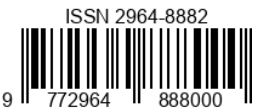Usaha Hamba Tuhan Memaksimalan Penggunaan Teknologi Sebagai Wujud Penerapan Misio Dei Bagi Dunia Di Era Digital
DOI:
https://doi.org/10.55606/lumen.v2i1.173Keywords:
Servant of God, Technology, Misio Dei,, World, In the Digital AgeAbstract
In human history, changes have always occurred, so everyone must be able to keep up with changes in order to adapt. For example, in terms of technological progress, the changes are increasingly unstoppable. In general, the most popular digital technology today is social media. The purpose of writing this article is to discuss how God's people can utilize technology in an effort to maximize the application of divine mission (Misio Dei) for the world in the digital era. With this, the research method used by the author is a qualitative research method. For this reason, the Servant of God needs to utilize social media as a tool to spread the gospel message and promote it. They need to have an effective strategy for using social media, such as creating interesting and relevant content, interacting with congregations online, and utilizing social media features to spread church messages. Servants of God need to keep abreast of technological developments and adopt the latest technologies that are relevant to the mission of the church. Because, this article aims to provide guidance and inspiration to God's people on how to use technology effectively and responsibly in the context of ecclesiastical missions.
References
Amiman, R. V. (2018). Penatalayanan Gereja Di Bidang Misi Sebagai Kontribusi Bagi Pelaksanaan Misi Gereja. Missio Ecclesiae, 7(2), 164–187.
Bosch, D. J. (2011). Transforming mission: Paradigm shifts in theology of mission (Issue 16). Orbis books.
De Jong, K. (2007). Misiologi Dari Perspektif Teologi Kontekstual. Gema Teologi, 31(2).
Denzin, N. K., & Lincoln, Y. S. (2011). The Sage handbook of qualitative research. Pustaka Belajar.
Gulo, E. K. (2022). Studi Kualitatif Pemanfaatan Media Digital dalam Pelayanan Gereja. HINENI: Jurnal Ilmiah Mahasiswa, 2(1), 19–25.
J. Andrew Kirk. (2017). Apa Itu Misiologi? BPK Gunung Mulia.
Keryapi, D. S. (2021). Rekonsiliasi sebagai Paradigma Misi Trinitarian Inkarnasional dan Konstruksinya pada Ruang Publik. SOTIRIA (Jurnal Theologia Dan Pendidikan Agama Kristen), 4(1), 37–46.
Lexy Moleong J. (1998). Metode Penelitian Kualitatif, Bandung: Remaja Rosdakarya. In Muhadjir, Noeng. Remaja Rosdakarya.
Objantoro, E. (2018). Religious pluralism and Christian responses. Evangelikal: Jurnal Teologi Injili Dan Pembinaan Warga Jemaat, 2(1), 123–133.
Putra, B. H. (2022). Tinjauan Teologis Ibadah Dalam Metaverse Di Era Pandemi Dan Kemajuan Teknologi. Syntax Literate; Jurnal Ilmiah Indonesia, 7(5), 5781–5795.
Ronda, D. (2019). Kepemimpinan Kristen Di Era Disrupsi Teknologi. Evangelikal: Jurnal Teologi Injili Dan Pembinaan Warga Jemaat, 3(1), 1. https://doi.org/10.46445/ejti.v3i1.125
Salurante, T. (2021). Berteologi Global dan Bermisi dalam Konteks: Sebuah Usulan Kontekstualisasi Kekristenan Masa Kini. EPIGRAPHE: Jurnal Teologi Dan Pelayanan Kristiani, 4(2), 225–235.
Susanto, H. (2019). Gereja Yang Berfokus Pada Gerakan Misioner. FIDEI: Jurnal Teologi Sistematika Dan Praktika, 2, 62–80.
Sutaryono, P. (2017). Tantangan Disrupsi Teknologi. Kompas Online, Tanggal, 9.
Trisyanti, U., & Prasetyo, B. (2018). Revolusi Industri dan Tantangan Revolusi Industri 4.0. Prosiding SEMATEKSOS 3 “Strategi Pembangunan Nasional MenghadapiRevolusiIndustri 4.0,” 22–27.
Tuai, A. (2020). Strategi Pelibatan Anggota Jemaat Mewujudkan Misi Gereja Yang Sehat. Integritas: Jurnal Teologi, 2(2), 188–200.
Verkuyl, J. (1978). Contemporary Missiology: An Introduction. Translated and edited by DaleCooper. Grand Rapids: William B. Eerdmans Publishing Company.
Widi Artanto. (2016). Gereja dan Misi-Nya. Yayasan Taman Pustaka Kristen Indonesia.
Widjaja, F. I., Ginting, D., & Hutagalung, S. M. (2019). Teologi Misi Sebagai Teologi Amanat Agung. THRONOS: Jurnal Teologi Kristen, 1(1), 17–24.
Downloads
Published
How to Cite
Issue
Section
License
Copyright (c) 2023 Freddy Lans Deo Dawolo

This work is licensed under a Creative Commons Attribution-ShareAlike 4.0 International License.










